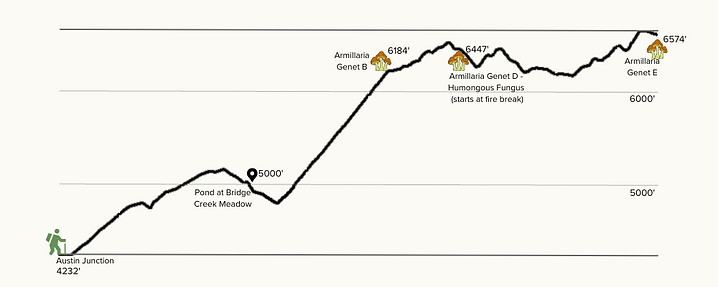

Hike on the BMT:
Humongous Fungus
Humongous Fungus - 1-2 days
Following National Forest Roads south of Austin Junction, Oregon, visit a remarkable destination, the largest known organism on Earth. The Humongous Fungus is at least 2,500 years old and extends over 2,385 acres. That's over 3.5 square miles!

the stats:
Recreation type: Day hike, vehicle, or multi-day backpack
Route type: One way with shuttle, loop, or out-and-back
Mileage: 19 miles one way, with shorter and longer options
Duration: 1-2 days
Elevation gain/loss (gross): 3,514 feet
Active time hiking (estimated): 6 hours one way
Time of year: Early fall to see mushroom fruit bodies
Physical difficulty: Moderate
Logistical difficulty: Moderate, 4WD vehicle recommended if driving forest roads, and 2 vehicles needed for a shuttle
Permits required: None
Planning links:
Trailhead access points: Austin Junction - Google Maps link — Elk Creek CG - USFS link - Google Maps link
Nearby town guide: Austin Junction
Local US Forest Service Office: Malheur National Forest Prairie City Ranger District, 541-820-3800
Local area conditions: Elk Creek Campground
Weather forecast at Crane Creek Trailhead: National Weather Service

Trip description:
Of the many superlatives associated with the landscapes, flora and fauna of the Blue Mountains Trail, a chance to visit the largest organism in the world may be the grandest. In an otherwise nondescript section of the Malheur National Forest, a network of honey mushrooms, Armillaria ostoyae, extends over 2,385 acres; based on its size, scientists estimate it is between 1900 and 8500 years old. Other large specimens, referred to as genets, are in the nearby vicinity, and the main and alternate routes of this section of the Blue Mountains Trail intersect with them. They can be visited by a day hike, as a multi-day trip, or if you have the patience to drive on gravel roads in a somewhat complicated road network, you can also drive to visit them in one day.
The map and this trip description starts from Austin Junction. The largest of the Armillaria genets is gaining increased exposure and has been popularly named the Humongous Fungus. It can be reached by navigating a few national forest roads in a somewhat complicated road network, by following NF Road 091 for 7 miles, and then following NF Road 026 for another 5.5 miles to reach a fire break that runs along NF 026, where the The Humongous Fungus also starts and continues underfoot for 3 miles of the road. By continuing past the Humongous Fungus for another 5 miles, you will reach the smaller, but still huge, Genet E honey mushroom. This organism spans 482 acres and it lies in old growth forest, showing how Armillaria ostoyae impacts undisturbed forests and tree. The other genets, including the Humongous Fungus, are in forests that have been logged or recently have been impacted by wildfires. Interestingly, these mushrooms will decompose and kill live trees as they expand, in a process that largely goes unseen. Dead trees exhibit the mycelial nets that grown under host tree bark like latex paint, and black, shoestring-like rhizomorphs may also be visible. Many dead and distressed trees will be visible in areas where the Armillaria mushrooms are present. In the early fall, mushroom fruit bodies erupt from the tree trunks in an impressive display. Given the ancient age of these mushrooms, fires appear not to impact the subsurface organism.
If you choose to hike to visit the Humongous Fungus, prepare to carry sufficient water. While there are many creeks in this area, there are few good spots from the ridgeline roads to reach them. Ponds and water sources are indicated on the map, and you will need to bring a filter or tablets to treat the water. From the Humongous Fungus or Genet E, you can extend the trip by continuing to Elk Creek Campground or one of the other nearby campgrounds on the South Fork of Burnt Creek. You can set up a shuttle to do this trip as a one-way, or you can also do an out-and-back from these campgrounds. If you choose to start from from Elk Creek Campground, it is 5 miles to reach Genet E, and it is another 6 miles to reach the Humongous Fungus.
For more information on these incredible, ancient mushrooms, download and read this short paper written and published by scientists working for the U.S. Forest Service in 2008.
maps and elevation profile:


Download:
Full guide with hiking map (6 pages, 12.3 mb)
Map only (4 pages, 10.2 mb)
GPX map (89 kb)
Before and After in Austin Junction
More roadhouse than town, Austin Junction is an unincorporated community in the Malheur National Forest. The only business, Austin House, is a combination market, gas station, restaurant, ice cream parlor, and tavern. For thru-hikers and multi-section hikers on the Blue Mountains Trail, the Austin House will accept hiker resupply boxes; however, please call to coordinate and confirm. Enjoy the refreshments and ask permission to park your vehicle if you plan to leave from Austin House for a hike to visit the Humongous Fungus and the other nearby Armillaria ostoyae genets in the Malheur National Forest.
Bates State Park and Campground is a mile away and can be reached by foot or a short drive. The state park is built on the site of a historic sawmill that demonstrates the extensive logging in the Blue Mountains over much of the 20th century. The campground also has day use areas and short hiking trails along the old mill pond. The Middle Fork John Day River is just north of the state park. A few other seldom used campgrounds can be found along the Middle Fork Road.
Prairie City is the nearest town to Austin Junction, 18 miles southwest along US-26. Sumpter is also a short drive in the other direction. It can be reached by following OR-7 24 miles and then 3 miles on OR-410.
